How many churches are there in Iceland? Are Icelanders religious? You may have heard of Hallgrímskirkja or the black church of Búðir, but there are many more houses of worship to discover! Read on to learn more about the history of Christianity in Iceland and fall in love with this country's churches.
There are more than 350 churches across Iceland. For a nation of only 330,000 people, that's a high number and may lead some to think that Icelanders are particularly religious.
Why You Can Trust Our Content
Guide to Iceland is the most trusted travel platform in Iceland, helping millions of visitors each year. All our content is written and reviewed by local experts who are deeply familiar with Iceland. You can count on us for accurate, up-to-date, and trustworthy travel advice.
- Introduce yourself to the Fascinating History of Icelandic Architecture
- Read about the History of Iceland
Religion in Iceland

When Icelanders are born, they are immediately registered as Christians in the Lutheran church of Iceland. Fourteen-year-olds are traditionally confirmed, and this is a common rite of passage into adulthood.
In 2015, Iceland was voted the most godless country in Europe, given that hardly any young people believe that God created the world, as well as the fact that a very high number of children are born outside of wedlock.
Travel anywhere in Iceland, however, and you cannot help but spot a church, sometimes even in the most random of places. This article will introduce you to some of the most intriguing and beautiful churches in Iceland.
History of Christianity in Iceland
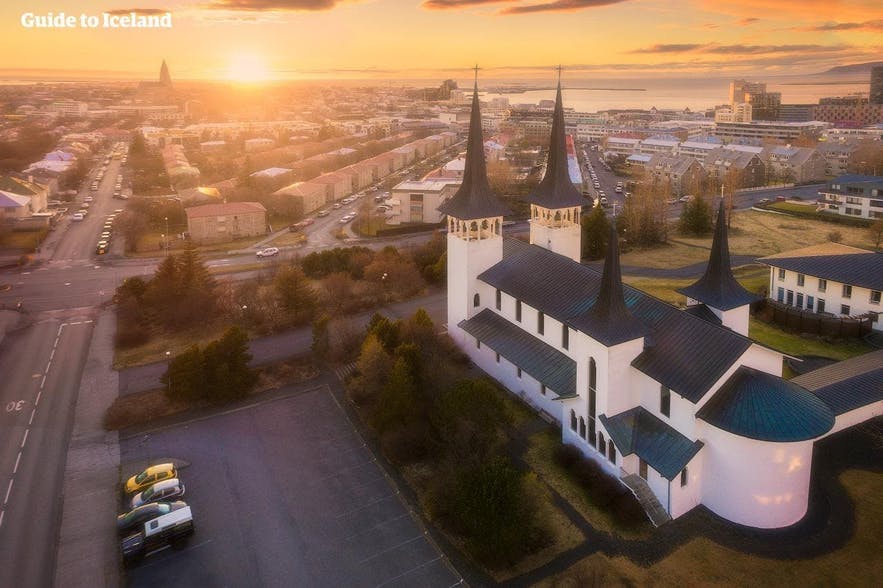
Iceland was Christianised in 1000 AD by law, although the history of Christianity goes back to the earliest Irish hermit settlers in the Early Middle Ages, 100 years before the Norse arrived. The lawful adoption of Christianity was a compromise between the heathen and Christian chieftains, and Christianisation brought with it certain advantages, such as literary traditions replacing oral histories.
Although Icelanders were technically Christian and had to be baptised, many kept their old pagan faith and stories in secret. Some were even allowed to continue to eat horse, usually prohibited by the Christian faith for its association with Germanic pagan practices.
As in other countries, many people would will their property to the church upon their death, which led to the gradual rise of the church and its power in Iceland. The popularity of religious practice has greatly declined in Iceland since the 1970s, and a very small percentage of the country attends church services except for at Christmas or a relative's confirmation, wedding, or funeral.
- See also: The Most Infamous Icelanders of History
The word for church in Icelandic is 'kirkja', and the names for each church will feature this suffix. Although Icelanders do not regularly attend church services, there is a respect for their part in Icelandic history and, quite often, a deep appreciation for their beauty.
Not so long ago, churches across the country were left with their doors open, and visitors could stop by for a look or a quiet moment of contemplation. Unfortunately, due to the disrespectful actions of a few, they are now locked, and if you wish to have a look inside, you will have to check the local opening hours or mass schedule.
Blaa Kirkjan
 Photo by Free to Use Sounds
Photo by Free to Use Sounds
This visitor favourite is arguably one of the most beautiful churches in the country, inside and out. Named Bláa kirkjan, the 'Blue Church' for its pastel exterior colour, it sits in the idyllic fishing town Seyðisfjörður in the East of Iceland.
The first version of this church stood in a different location but was moved to the heart of Seyðisfjörður in 1920. In 1989, the church was damaged by a fire which also claimed a new pipe organ.
This church is open to visitors in the summer and has also featured as a venue for artists during the LungA arts festival, held annually in July. The church also runs its own string of summer performances called the Blue Church Summer Concerts.
Thingvallakirkja

This is one of Iceland’s earliest churches, as the original was consecrated in the 11th century. King Olaf II, whose reign began in 1015, sent timber and bells from Norway to encourage the building of the church in the newly Christian Iceland.
The wooden church that stands at the site now was built in 1859 and still contains bells from earlier structures. Although small in size, its location in Þingvellir National Park makes it one of the most visited churches in Iceland. You can go inside the church during working hours from May to September and can, of course, see it on any Golden Circle tour—whatever the time of year!
Saurbaejarkirkja
Saurbæjarkirkja is located on Rauðasandur beach in the remote Westfjords and is a part of the Patreksfjörður parish. There has been a church on this spot dating back to the 17th century. The present building used to be in Reykhólar and was built in the middle of the 19th century and consecrated in 1963.
It was dismantled in Reykhólar and reconstructed in Saurbæ in 1982, where it stands today with the help of the local community and the National Museum. It’s a black building with a red roof and it looks particularly charming against the often moody sky and breathtaking landscape.
Budakirkja

The black church at Búðir, on the southern side of the Snæfellsnes peninsula, is a popular photography subject for its colour, dramatic positioning and minimalism.
Búðir once used to be a prosperous fishing village and trading port, yet it was abandoned at the beginning of the 19th century.
The photogenic church is all that remains of the former community at Búðir and there has been a church on the site since 1701. It is found located next to a grassy lava field and the beach, making for an undeniably picturesque scene.
The legend goes that the location for the church was determined by spinning a man in circles until he became dazed and then asking him to fire off three arrows. The church was to be built where the last arrow landed.
Hvalsneskirkja
 Photo from Wikimedia, Creative Commons, by Bromr. No edits made.
Photo from Wikimedia, Creative Commons, by Bromr. No edits made.
This beautiful church and adjacent graveyard were built in 1887 from carved stone from the region. Hvalsneskirkja's interior is made from driftwood, all of which was collected from nearby beaches.
This charming structure is located in Sandgerði, on the Reykjanes peninsula. A significant person is buried in the graveyard; the only daughter of a nationally revered poet, Hallgrímur Pétursson, who served as a priest in the area. It’s only a few minutes drive from the Keflavík International Airport.
Strandarkirkja
 Photo from JNC2
Photo from JNC2
Strandarkirkja is located in the South of Iceland in a place called Seal Cove ‘Serlvogar’. It was originally built in the 12th century.
One legend tells of a group of fishermen who were in trouble just off the coast. They prayed to God to be saved, promising to build a church if He delivered them from danger. An angel then appeared and steered them to safety. Of course, the fishermen kept their promise and built Strandarkirkja, as well as naming the coastline Engilsvík ('Angel’s Bay').
Many miracles have been attributed to Strandarkirkja and it is famous around the world as a ‘miracle church’. It used to be the richest in Iceland for the large amounts of contributions it received from folk hoping to share in a bit of its good fortune.
- See also: Getting Married in Iceland
Vikurkirkja

The church at Vík is one of the most famous in Iceland as it is the centrepiece of the town Vík, a popular spot to visit on Iceland’s South Coast. The church is also the meeting place should there be any volcanic activity if the dreaded Katla should start rumbling.
It has even been predicted that in the case of Katla erupting, Víkurkirkja would be the only building to survive the subsequent flash floods from the melting of Iceland’s fourth largest glacier, Mýrdalsjökull.
Flateyarkirkja
Flatey is a tiny island within the enormous fjord Breiðafjörður, which separates the Snæfellsnes peninsula and the Westfjords.
The island is best characterised by its well-kept and brightly coloured houses, as well as the idyllic views from its uniquely remote location. The church on the island is most notable for the mural that decorates the wall behind the altar.
It was originally painted by the father of famous Icelandic movie director, Baltasar Kormákur’s for his film White Wedding Night. The mural shows Jesus dressed in a very sensible jumper and resembles an Icelandic fisherman, a novelty that makes it well worth a visit.
All of the characters that decorate the walls are residents of the island. You can get there by taking the ferry Baldur from Stykkishólmur.
Hlidarendakirkja
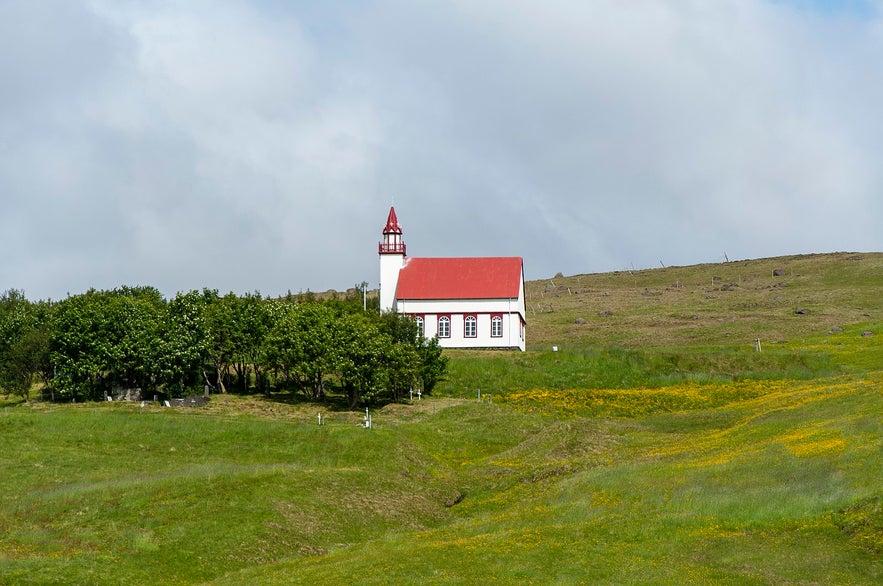 Photo from Wikimedia, Creative Commons, by Hansueli Krapf. No edits made.
Photo from Wikimedia, Creative Commons, by Hansueli Krapf. No edits made.
Hlíðarendakirkja is an ornate and pretty church, built in 1897 with room enough to seat an impressive 180 people. The surrounding farmstead, Hlíðarendi, is famous as the home of Gunnar, one of the two tragic heroes of Njál’s Saga and one of Iceland’s most revered literary gems.
In the story, Gunnar is preparing to leave the country in exile. When he returns to his beautiful homestead, he refuses to part from his home and country. Unhappy, his enemies show up to kill him and one of the most famous passages tells of how he defended himself until his bowstring broke.
He requested a strand of hair from his wife, Hallgerður, who subsequently refuses him in return for a slap he once gave her.
- See also: Icelandic Literature for Beginners
If you are driving the South Coast, you can pay this church a visit—it is very close to Hvolsvöllur and has amazing hillside views.
Kirkjubaer
 Photo from Wikimedia, Creative Commons, by Gerd Eichmann. No edits made.
Photo from Wikimedia, Creative Commons, by Gerd Eichmann. No edits made.
Although no longer a church, this building is worth mentioning for its pristine beauty. It’s pretty blue and white exterior stands out against the beautiful surrounding landscape and can now actually be rented out for private accommodation.
Located in Stöðvarfjörður, in the East of Iceland, it was built in 1925 and guarantees a unique guesthouse experience.
Husavikurkirkja
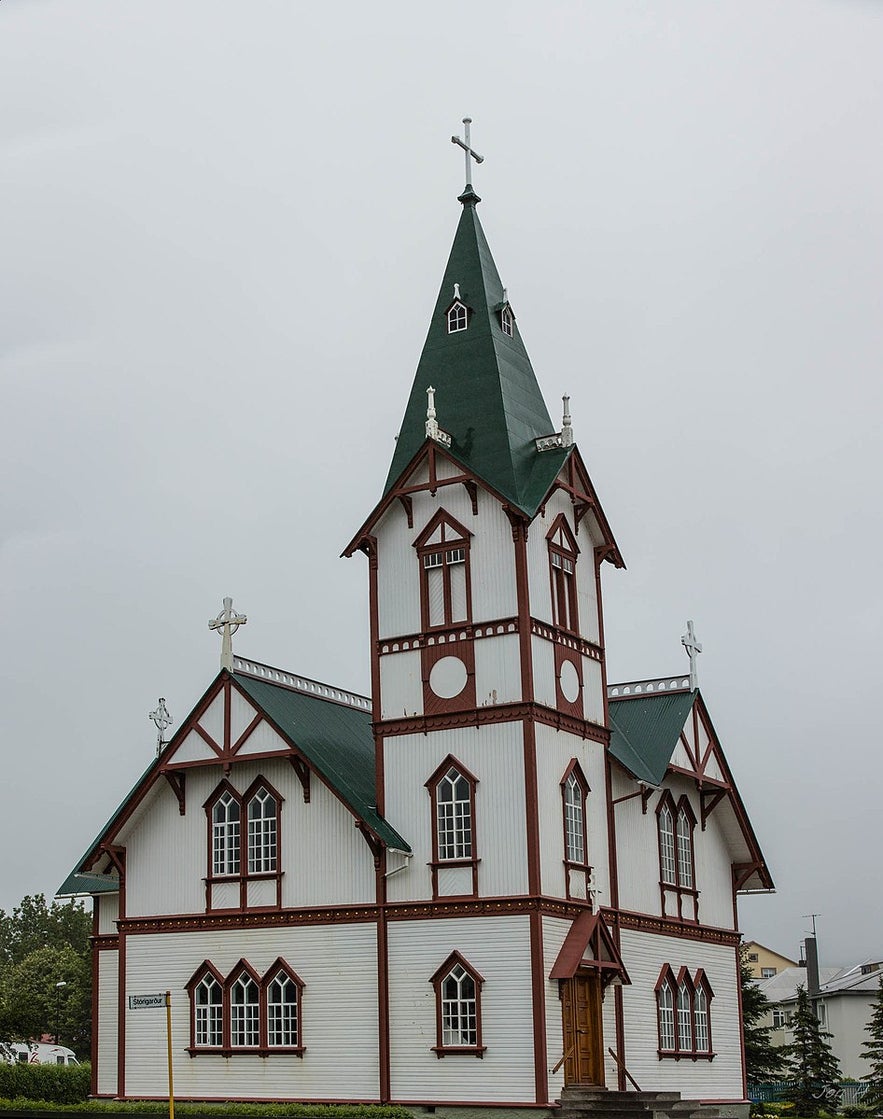 Photo from Wikimedia, Creative Commons, by Jon Gretarsson. No edits made.
Photo from Wikimedia, Creative Commons, by Jon Gretarsson. No edits made.
This church stands by the harbour in the picturesque village of Húsavík dubbed the whale watching capital of Iceland for its rich marine life and variety of cetacean species.
This grand and ornate building is built from Norwegian wood and is fashioned with a strong Schweitzer style. It was finished and consecrated in 1907 and is open to any visitors who fancy a look inside!
Saebolskirkja
 Photo by Regína Hrönn Ragnarsdóttir
Photo by Regína Hrönn Ragnarsdóttir
Sæbólskirkja is special for its incredibly remote location in the already far-flung Westfjords.
The modest building has stood there since 1929 and it’s a popular shooting location for photographers thanks to its vivid, red and white colour and gorgeous surrounding landscape. If you're looking for stunning scenery and charming historical architecture, there's no better choice during your time in the Westfjords.
Heimaey Stave Church
 Photo from Wikimedia, Creative Commons, by Sakaris Ingolfsson. No edits made.
Photo from Wikimedia, Creative Commons, by Sakaris Ingolfsson. No edits made.
This church is to be found on Heimaey island, a part of the Westman Islands. It is a close replica of the Haltdalen stave church, which used to stand within the island's harbour area.
To commemorate Iceland’s one-thousandth anniversary of formal Christian conversion, the Norwegian state presented this church as a gift. It was positioned in an area freshly created by the 1973 volcanic eruption, a natural catastrophe that devastated the island community for years.
Stave churches are rarely found outside of Norway, making this structure particularly striking to look at. Its eye-catching appearance fits in nicely with the dramatic history of the Westman Islands.
Hallgrimskirkja
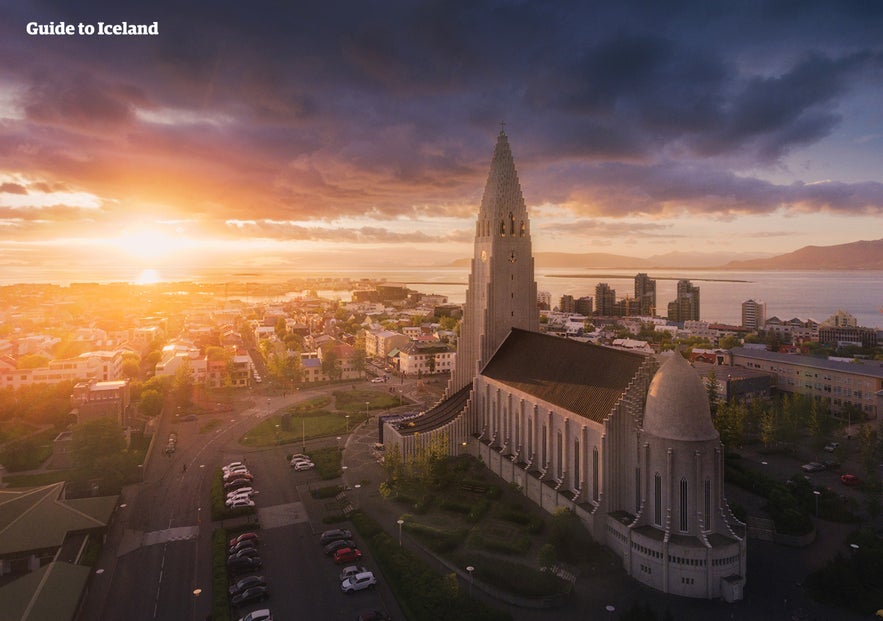
It wouldn't be possible to write about Iceland's churches without mentioning Hallgrímskirkja, the largest church in Iceland.
It was designed by Iceland's most famous architect, Guðjón Samúelsson who is responsible for countless impressive buildings around Iceland, including the National Theatre and the church in Akureyri.
Hallgrímskirkja was named after a 17th-century poet and the author of the nationally revered Passion hymns (Passíusálmur), Hallgrímur Pétursson.
Its design is inspired by Icelandic nature, taking aspects glaciers, mountains and lava formations—especially the hexagonal basalt columns that feature behind Svartifoss waterfall in Skaftafell Nature Reserve.
It took 41-years to build and was finally completed in 1986. The pipe organ inside took slightly longer to be finished taking up until 1992 and consists of over 5000 pipes.
A symbol of Reykjavík, many flock to capture its beauty for themselves. It is possible to take an elevator to the top of the tower to enjoy panoramic views of the city although you can expect to wait a while as it is quite popular.
Akureyrarkirkja
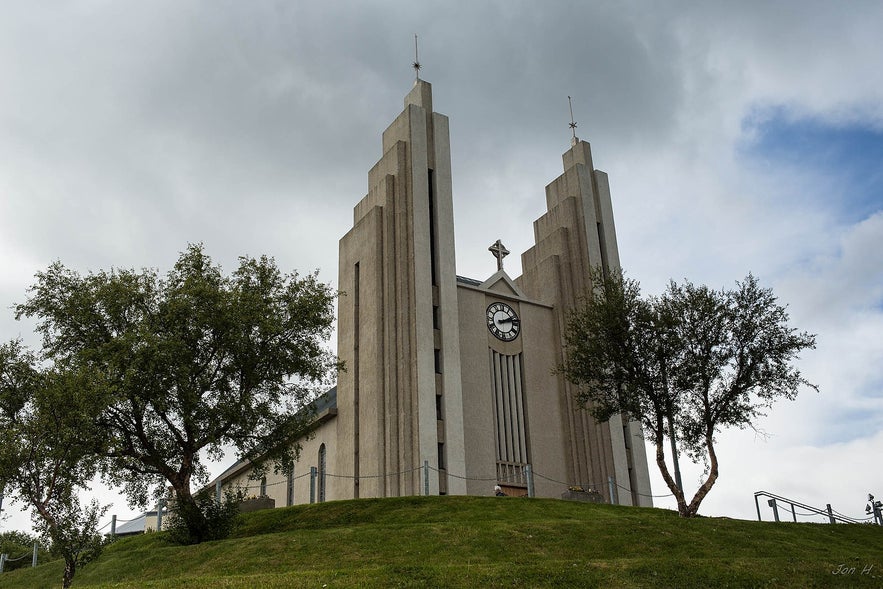 Photo from Wikimedia, Creative Commons, by Jon Gretarsson. No edits made.
Photo from Wikimedia, Creative Commons, by Jon Gretarsson. No edits made.
This church dominates the landscape of Akureyri and it is definitely one of the town's most distinctive landmarks. As mentioned above, it was designed by Guðjón Samuelsson and it is possible to spot similarities with other works of his.
The stained glass windows have quite the story behind them. During World War II, the pretty panes of glass were removed from Coventry Cathedral for fear of damage by bombs. The glass subsequently went missing. The windows were unwittingly bought for Akureyrarkirkja where they remain today!
Turf Churches
These traditional structures are based on materials and architectural styles of the first settlers of the 9th century. Forests were far more plentiful at the time although there was most likely always a shortage of wood; indigenous trees didn’t grow to be very tall and were not so substantial for timber and trees grew slowly because of the weather.
The first settlers would greatly rely on driftwood as the Gulf Stream brought a lot of it from the North American continent. Timber would also be imported from Norway but it was costly and in limited supply.
Turf proved to be an excellent alternative; most towns had an area it could be cut from and it was free and accessible. It also held many advantageous qualities over wood as it keeps the cold and wet out and doesn’t blow over in stormy weather.
Most turf churches exist in the North of Iceland as the weather conditions are not as wet and the turf did not need to be replaced as often. There are six remaining in Iceland today and they are delightful to look at as well as rich in history.
Vidimyrarkirkja
 Photo by Regína Hrönn Ragnarsdóttir
Photo by Regína Hrönn Ragnarsdóttir
Víðimýrarkirkja is located close to Varmahlíð in Skagafjörður, Northern Iceland. There has been a church recorded there since 1318 although it is supposed a church has stood there since the first century of Christianity in Iceland.
The current church was built in 1834 by the politician Jón Samsonarson. The clock in the church tower dates from 1630. There is a cemetery and the wall that encloses it is also turfed.
Árbæjarkirkja
 Photo from Wikimedia, Creative Commons, by Jon Gretarsson. No edits made.
Photo from Wikimedia, Creative Commons, by Jon Gretarsson. No edits made.
This church was originally built in Skagafjörður but when a new church was built there, the older structure was moved to Árbær.
In Reykjavík, the church was restored to its original image and it was made part of the Árbærsafn museum in 1960. The original architect was the same as Víðimýrakirkja, Jón Samsonarson, and the exterior is painted black like its sister church.
Grafarkirkja
 Photo by Regína Hrönn Ragnarsdóttir
Photo by Regína Hrönn Ragnarsdóttir
Grafarkirkja is located in the eastern part of Skagarfjörður, about two miles south of Hofsós—also home to a breathtaking infinity swimming pool. It is considered to be the oldest turf church in Iceland and was built in the last quarter of the 17th century by the Hólar bishop, Gísli Þorláksson.
The Danish King, Friðrik V ordered for the church to be abolished in 1765 and it existed as a ruin until 1960 when the National Museum acquired the church and restored it to its original form. The bishop of Iceland restored it as a place of worship in 1953.
Saurbaejarkirkja (another one!)
 Photo by Regína Hrönn Ragnarsdóttir
Photo by Regína Hrönn Ragnarsdóttir
Saurbæjarkirkja is located in the innermost village of Eyjafjörður in the Noth of Iceland, 25-km south of Akureyri.
There has been a church at Saurbær for as long as there have been people there. During its Catholic period, the church was dedicated to Saint Cecile and Saint Nicolas.
The current building was built in 1858 by the Reverend Einar Thorlacius and was in the hands of the church until 1931. This beautiful church is now in the care of the National Museum and has received heavy repairs.
It is the largest preserved turf church to exist in Iceland and it seats up to 60 people.
Hofskirkja

Located to the south of Öræfajökull glacier to the East of Skaftafell, it is the youngest of the turf churches in Iceland. There has been a church at Hof for more than 700 years and although the current turf church is new, religious practice on this site is historic.
The structure that stood here during the Catholic times was dedicated to Saint Klemens.
The original turf church was built in 1883-1885 by Paul Pálsson and was restored by the National Museum in 1954, It is still the parish church of the Öræfinga area. There is a cemetery bound by a turf wall.
Nupsstadarkirkja
 Photo by Regína Hrönn Ragnarsdóttir
Photo by Regína Hrönn Ragnarsdóttir
Located in a small rural area west of Vatnajökull close to the famous mountain Lómagnúpur, there is a small church in Núpsstaðir which is, in fact, the smallest of the turf churches.
The earliest records report a church being there are since 1340, although it is safe to assume there has been a church there a lot longer.
In 1930, the National Museum took it over and it was restored as a church proper between 1958-1960. In 1972, the roof and cladding were completely replaced but the original foundations remain untouched. The alter that stands inside is over 200-years old and lava and stone murals decorate the walls of the church.
Did you find this article interesting or helpful? Do you have a favourite church in Iceland? Do you think there should be another church on this list? Leave us your thoughts in the comments.















